
- Disneyland® Paris Tickets
- Eiffel Tower Tickets
- Louvre Museum Tickets
- Paris Catacombs Tour & Tickets
- Versailles Tickets
- Notre-Dame Paris Tickets
- Orsay Museum Tickets
- Paris Pantheon Tickets
- Arc De Triomphe Tickets
- Opera Garnier Paris Tickets
- Big Bus Paris Hop-on Hop-off Tours
- Parc Astérix Paris Tickets
- Sainte Chapelle Tickets
- Eurail Passes
- Musee de l'Orangerie Tickets
All You Need to Know About Les Invalides
Quick Facts about Les Invalides
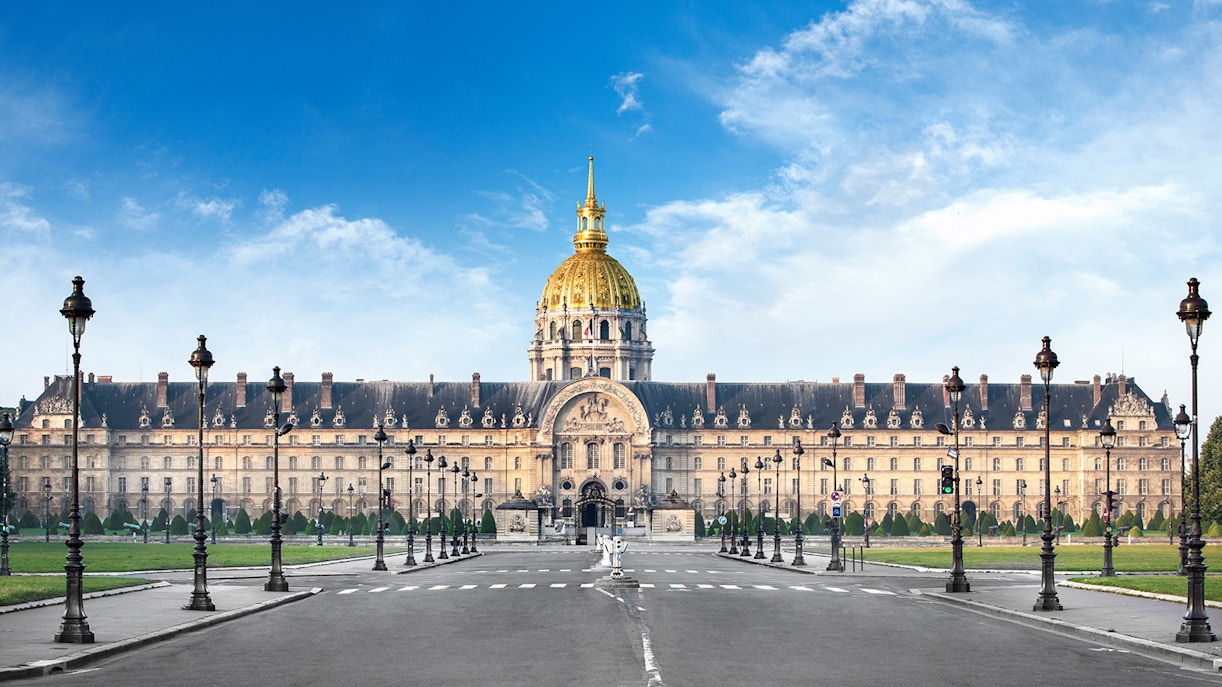
- Official name: Les Invalides
- Location/Address: 75007 Paris, France
- Date of opening: 1674
- Timings: 10 AM to 6 PM; Daily.
- Architect: Libéral Bruant and Jules Hardouin-Mansart
- Architectural style: Baroque
- UNESCO World Heritage Site: Inscribed in 1991 as part of the "Paris, Banks of the Seine" World Heritage Site
- Number of visitors per year: Approximately 1.2 million
- Function: Museum, church, hospital
- Collection size: Nearly 140,000 pieces
Why Visit Les Invalides

- Visit Napoleon's Tomb: See the final resting place of one of the world's most famous military leaders in the impressive Dome Church.
- Learn all about the French Military: Explore 140,000 pieces in total, with over 5,000 historical figurines, that showcase the diversity of the Army Museum’s collection.
- Baroque Architecture: Admire the stunning Baroque architecture of the buildings and the intricate details of the church's interior.
- The Hospital: Learn about the history and function of the hospital that continues to provide care to French veterans.
- Enjoy a tranquil stroll through the Courtyard: Escape from the bustling city and enjoy the beautiful gardens, fountains, and statues in the gardens and the courtyard.
- Explore the Heart of Paris: Les Invalides is conveniently located near other Parisian attractions such as the Eiffel Tower, Seine River, Rodin Museum, and even Musee D’Orsay
Plan Your Visit to Les Invalides
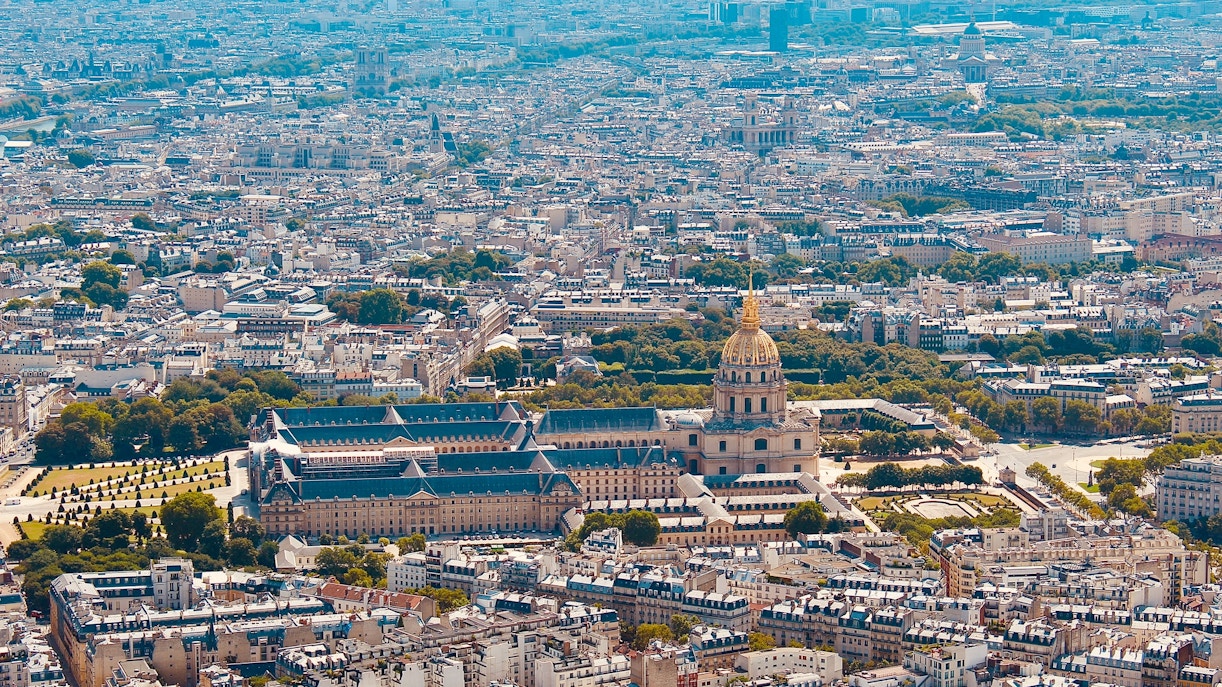
Timings: 10 AM to 6 PM; Daily
Closed: January 1, May 1, and December 25
Best time to visit: The best time to visit Les Invalides is during the spring or fall when the weather is mild and the crowds are smaller. Weekdays are also typically less busy than weekends.
Best Time to Visit Les Invalides
Address: 75007 Paris, France
Les Invalides is located in the 7th arrondissement of Paris, on the left bank of the Seine River. It is situated near several other notable landmarks, including the Eiffel Tower, the Musée d'Orsay, and the Champs-Élysées.
Closest Station: Invalides
Get Directions to Les InvalidesInside Les Invalides

Musée de l'Armée
Musée de l'Armée offers a journey through French history, covering military, political, social, and industrial aspects. The exhibits are arranged chronologically and thematically, allowing visitors to relive the great battles and discover the life of soldiers and discover how technologies and tactics were developed.
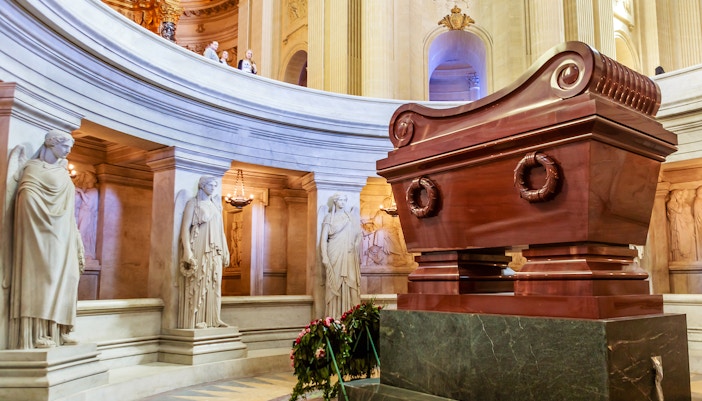
The Tomb of Napoleon
Originally used as a royal church during the reign of Louis XIV, the Dôme des Invalides later became the final resting place of Napoleon I in the 19th century. During World War II, it provided shelter for Allied pilots.

Main Courtyard
At the heart of the Hôtel National des Invalides site lies the main courtyard, which serves as a central hub for events and activities. You can take in a significant portion of the complex's vast collection of artillery and monumental sculptures from this central spot.
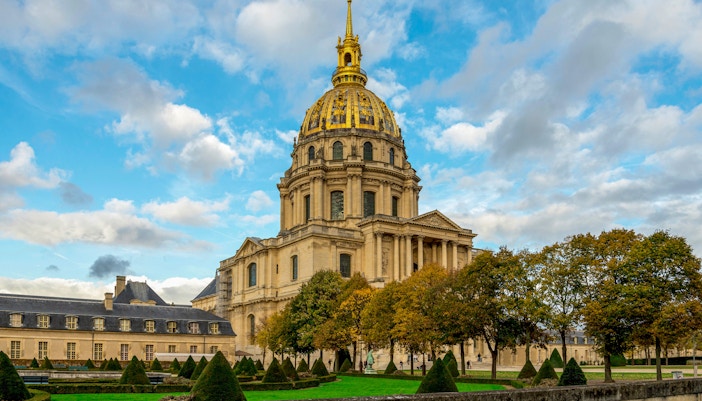
The Hôtel National des Invalides
With its iconic Dome and Baroque-style architecture, it is one of the city's most recognizable landmarks. The Musée de l'Armée's extensive collection of artifacts and exhibits showcase France's rich military history, while the Tomb of Napoleon I is a poignant reminder of the country's powerful leaders. You can also learn about the complex's function as a hospital for wounded veterans and explore the beautiful gardens and courtyards.

Extraordinary Cabinets
Explore a unique collection of rarely displayed and lesser-known items that showcase the diversity and richness of Les Invalides' collections. The newly opened space is divided into two rooms. In the first room, visitors can marvel at a collection of ancient figurines, including sets of paper, lead, and tin toy soldiers, as well as scale models of artillery pieces. The second room is dedicated to the history of ancient musical instruments, displaying a variety of instruments from different periods and cultures.
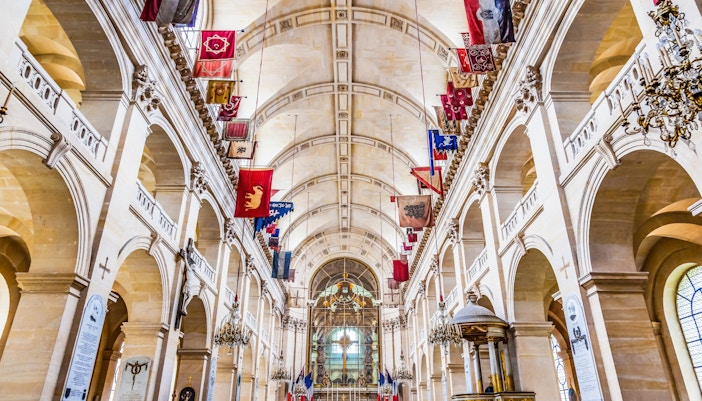
The St. Louis Cathedral
The Saint-Louis Cathedral offers you a glimpse into the importance of religious faith during the reign of Louis XIV. The cathedral's rich history and architecture provide a unique opportunity for you to immerse yourself in the splendor of the past. The interior of the cathedral is adorned with intricate carvings, beautiful stained glass windows, and other decorative elements that reflect the grandeur of Louis XIV's reign.
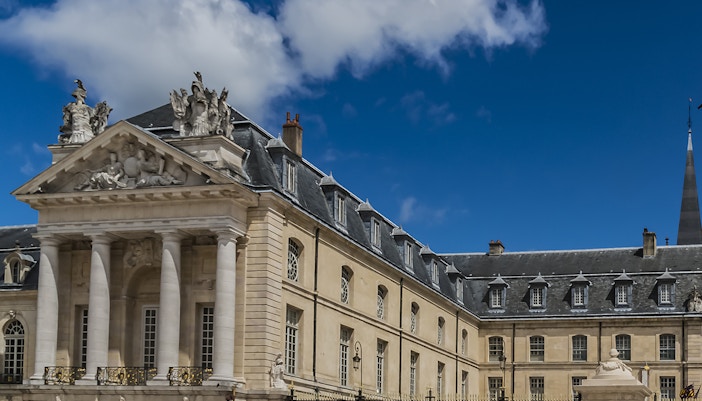
Musée de l'Ordre de la Libération
Musée de l'Ordre de la Libération is dedicated to the history of Free France from 1940 to 1945. The museum showcases the portraits of the Companions of the Liberation, who were individuals recognized for their efforts in the French Resistance during World War II. These portraits provide insight into the struggles and sacrifices made by those who fought for the liberation of France.

Relief Map Museum
Browse a rare collection of historical scale models showcasing over two centuries of military history. Relief maps were invented in the 17th century when Louis XIV's Minister of War, Louvois, asked Vauban to create a scale model of the city of Dunkirk. Today, the museum, located in the Hôtel des Invalides and managed by the Ministry of Culture, presents 28 examples of relief maps depicting fortified towns constructed between 1668 and 1875.
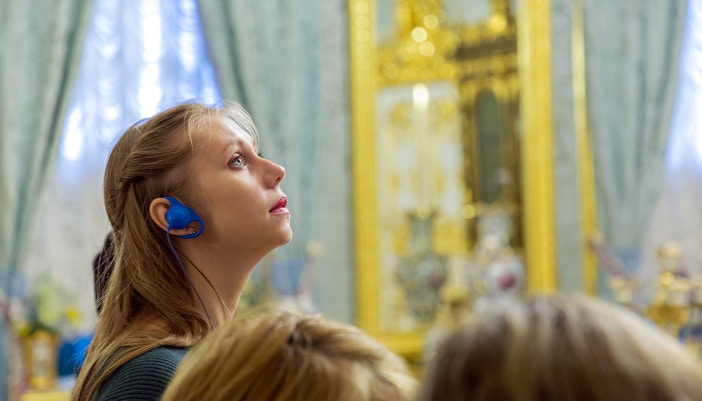
Historial Charles de Gaulle
The Historial Charles de Gaulle is a cutting-edge multimedia center devoted to the legacy of the celebrated statesman and leader of Free France, and subsequently the first President of the Fifth Republic. This immersive space, located underneath the Cour de la Valeur at Hôtel National des Invalides, has undergone more than a year of renovation work to offer visitors an engaging and interactive experience.
History of Les Invalides
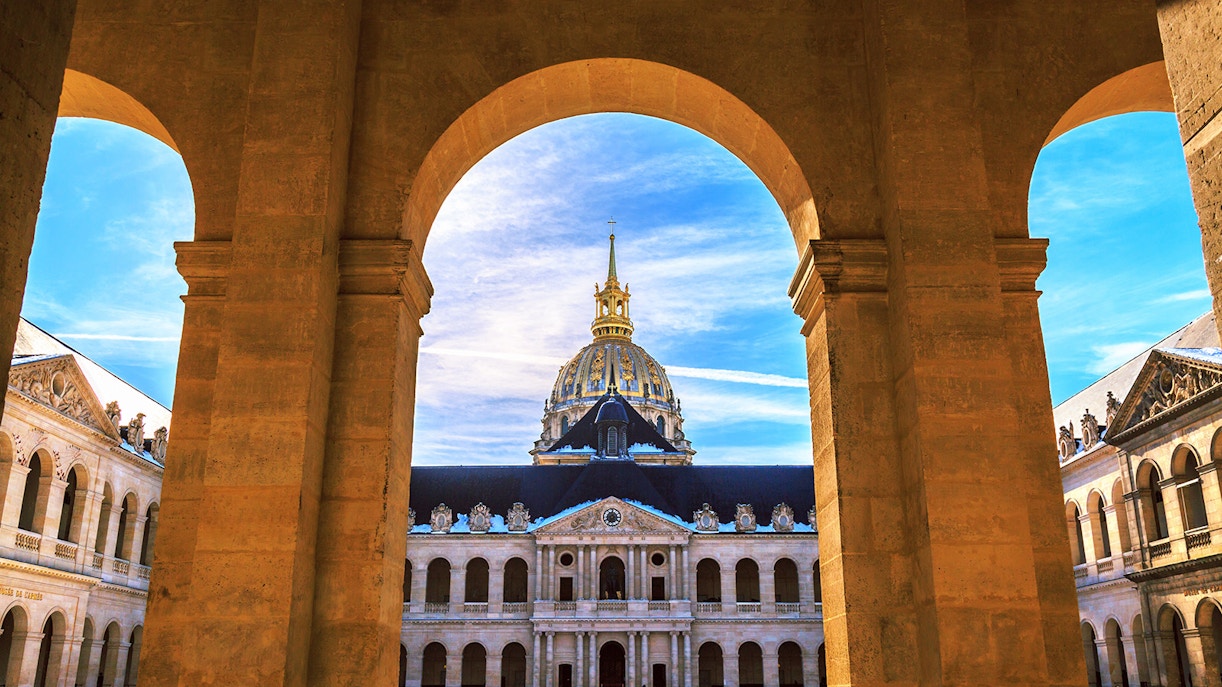
Louis XIV commissioned the construction of Les Invalides in 1670 as a home and hospital for disabled soldiers. Libéral Bruant was the initial architect, and the site chosen was a suburban plain in Grenelle. The project was completed in 1676, featuring a façade that measured 196 meters in width and fifteen courtyards, including a military parade courtyard called the cour d'honneur.
Jules Hardouin-Mansart designed the church-and-chapel complex of Les Invalides in 1676, taking inspiration from his great-uncle François Mansart's design for a Chapelle des Bourbons to be built behind the chancel of the Basilica of Saint-Denis.
The Dôme des Invalides was intended to be a new burial place for the Bourbon Dynasty but was instead designated as the private chapel of the monarch, barely used for that purpose.
Despite this, the Dôme des Invalides remains one of the prime examples of French Baroque architecture, standing 107 meters high and representing an iconic symbol of France's absolute monarchy.
Who Built Les Invalides?

Les Invalides was initially designed by the architect Libéral Bruant in 1671 as a home and hospital for aged and disabled soldiers. Later, the church-and-chapel complex of the Invalides was designed by Jules Hardouin-Mansart in 1676, taking inspiration from his great-uncle François Mansart's design for a Chapelle des Bourbons.
Hardouin-Mansart was a prominent architect during the reign of Louis XIV and was responsible for several notable projects, including the Palace of Versailles and the Grand Trianon. He is known for his contributions to the French Baroque architectural style.
The Architecture of Les Invalides
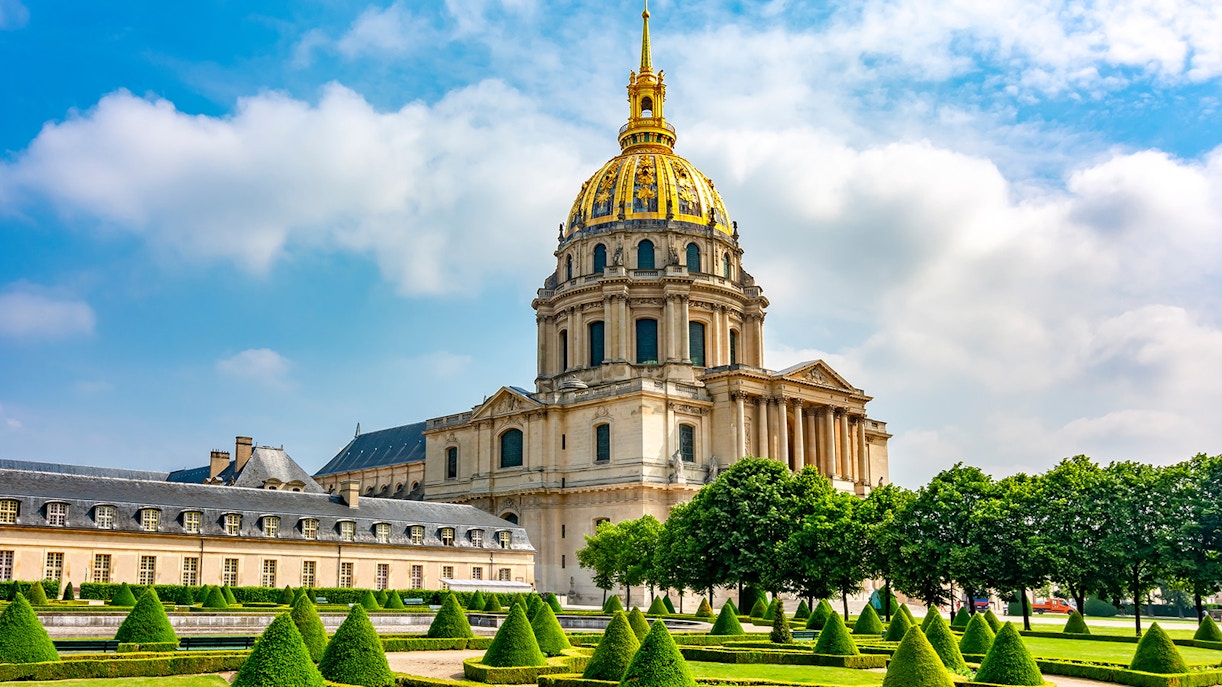
Les Invalides is a remarkable example of the French Baroque style, characterized by grandeur, symmetry, and ornamentation. The church of Saint-Louis-des-Invalides is one of the most prominent structures, with its golden dome towering over the city. The dome was inspired by St. Peter's Basilica in Rome and is adorned with beautiful frescoes and sculptures.
The façade facing the Seine River features classic French Baroque elements, such as pilasters, pediments, and balustrades.
The architect of the church and chapel complex was Jules Hardouin-Mansart, who was inspired by the design of his great-uncle François Mansart's Chapelle des Bourbons. Les Invalides stands as a testament to the grandeur of the French monarchy and its patronage of the arts and architecture.
Frequently Asked Questions About Les Invalides
A. Les Invalides is a complex of buildings in Paris, France, that includes a hospital and a retirement home for war veterans, as well as several museums.
A. Les Invalides is famous for its stunning architecture and historical significance, having been commissioned by Louis XIV as a home and hospital for disabled veterans and for being the burial site of Napoleon Bonaparte.
A. Les Invalides is located in 75007 Paris, France, on the left bank of the Seine River.
A. Les Invalides is a must-visit for history buffs, architecture enthusiasts, and those interested in the military history of France. The site is home to several museums and is a beautiful example of French Baroque architecture.
A. Tickets to Les Invalides can be purchased online. It's recommended that you purchase your tickets online to avoid the hassle of long lines and to enjoy greater deals and discounts.
A. The cost of admission to Les Invalides varies depending on which museums and exhibitions you wish to see.
A. Les Invalides was built under the direction of Louis XIV, with the initial architect Libéral Bruant and later Jules Hardouin-Mansart.
A. The first building of Les Invalides opened in 1676, with further additions being made to the complex in the following centuries.
A. Les Invalides contains several museums and exhibitions related to the military history of France, including the Army Museum, the Museum of Relief Maps, and the Charles de Gaulle Historial.
A. Les Invalides is open daily from 10 AM to 6 PM.
A. Les Invalides houses several famous artworks, including the tomb of Napoleon Bonaparte and the Grand Salon of the Hôtel des Invalides, which features a ceiling painted by Charles de La Fosse.
A. Les Invalides is important for its historical significance as a home and hospital for disabled veterans, as well as for its architectural and artistic significance as a prime example of the French Baroque style.
A. Yes, Les Invalides is definitely worth a visit for those interested in French history, art, and architecture, as well as for anyone looking to explore the many museums and exhibitions housed within the complex.
